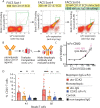This is a preprint.
Facile generation of biepitopic antibodies with intrinsic agonism for activating receptors in the tumor necrosis factor superfamily
- PMID: 38168220
- PMCID: PMC10760063
- DOI: 10.1101/2023.12.11.571146
Facile generation of biepitopic antibodies with intrinsic agonism for activating receptors in the tumor necrosis factor superfamily
Update in
-
Facile generation of biepitopic antibodies with intrinsic agonism for activating tumor necrosis factor receptors.Cell Chem Biol. 2024 May 16;31(5):944-954.e5. doi: 10.1016/j.chembiol.2024.03.010. Epub 2024 Apr 22. Cell Chem Biol. 2024. PMID: 38653243 Free PMC article.
Abstract
Agonist antibodies that activate cellular receptors are being pursued for therapeutic applications ranging from neurodegenerative diseases to cancer. For the tumor necrosis factor (TNF) receptor superfamily, higher-order clustering of three or more receptors is key to their potent activation. This can be achieved using antibodies that recognize two unique epitopes on the same receptor and mediate receptor superclustering. However, identifying compatible pairs of antibodies to generate biepitopic antibodies (also known as biparatopic antibodies) for activating TNF receptors typically requires animal immunization and is a laborious and unpredictable process. Here, we report a simple method for systematically identifying biepitopic antibodies that potently activate TNF receptors without the need for additional animal immunization. Our approach uses off-the-shelf, receptor-specific IgG antibodies, which lack intrinsic (Fc-gamma receptor-independent) agonist activity, to first block their corresponding epitopes. Next, we perform selections for single-chain antibodies from human nonimmune libraries that bind accessible epitopes on the same ectodomains using yeast surface display and fluorescence-activated cell sorting. The selected single-chain antibodies are finally fused to the light chains of IgGs to generate human tetravalent antibodies that engage two different receptor epitopes and mediate potent receptor activation. We highlight the broad utility of this approach by converting several existing clinical-stage antibodies against TNF receptors, including ivuxolimab and pogalizumab against OX40 and utomilumab against CD137, into biepitopic antibodies with highly potent agonist activity. We expect that this widely accessible methodology can be used to systematically generate biepitopic antibodies for activating other receptors in the TNF receptor superfamily and many other receptors whose activation is dependent on strong receptor clustering.
Keywords: 4–1BB; CD137; FcγR; OX40; TNF; TNFR; agonist; antibody; biepitopic; mAb; receptor clustering.
Conflict of interest statement
Competing interests The authors declare no conflicts of interest.
Figures





Similar articles
-
Facile generation of biepitopic antibodies with intrinsic agonism for activating tumor necrosis factor receptors.Cell Chem Biol. 2024 May 16;31(5):944-954.e5. doi: 10.1016/j.chembiol.2024.03.010. Epub 2024 Apr 22. Cell Chem Biol. 2024. PMID: 38653243 Free PMC article.
-
Tetravalent biepitopic targeting enables intrinsic antibody agonism of tumor necrosis factor receptor superfamily members.MAbs. 2019 Aug/Sep;11(6):996-1011. doi: 10.1080/19420862.2019.1625662. Epub 2019 Jun 20. MAbs. 2019. PMID: 31156033 Free PMC article.
-
Unlocking the potential of agonist antibodies for treating cancer using antibody engineering.Trends Mol Med. 2023 Jan;29(1):48-60. doi: 10.1016/j.molmed.2022.09.012. Epub 2022 Nov 4. Trends Mol Med. 2023. PMID: 36344331 Free PMC article. Review.
-
FcγRII-binding Centyrins mediate agonism and antibody-dependent cellular phagocytosis when fused to an anti-OX40 antibody.MAbs. 2018 Apr;10(3):463-475. doi: 10.1080/19420862.2018.1424611. Epub 2018 Jan 29. MAbs. 2018. PMID: 29359992 Free PMC article.
-
The emerging landscape of novel 4-1BB (CD137) agonistic drugs for cancer immunotherapy.MAbs. 2023 Jan-Dec;15(1):2167189. doi: 10.1080/19420862.2023.2167189. MAbs. 2023. PMID: 36727218 Free PMC article. Review.
References
-
- Abdiche Y.N., Miles A., Eckman J., Foletti D., Van Blarcom T.J., Yeung Y.A., Pons J., Rajpal A., 2014. High-Throughput Epitope Binning Assays on Label-Free Array-Based Biosensors Can Yield Exquisite Epitope Discrimination That Facilitates the Selection of Monoclonal Antibodies with Functional Activity. PLoS ONE 9, e92451. 10.1371/journal.pone.0092451 - DOI - PMC - PubMed
Publication types
Grants and funding
LinkOut - more resources
Full Text Sources
Research Materials
